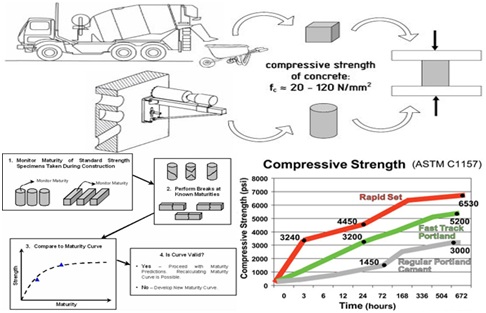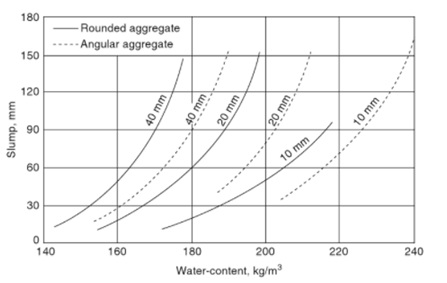INTRODUCTION
Strength and workability are both dominating factors in the making of concrete. Strength can be increased by increasing cement content but this in fact reduces the workability. Moreover,the water content can be increased for better workability, but this affects the strength. Hence,a perfect balance is to be maintained for both strength and workability. Furthermore, besides cement and water content, some other factors contribute greatly, which will be discussed as follows.
FACTORS AFFECTING STRENGTH
1. Water Cement Ratio – Water and cement are to be selected in such a way that it gives higher strength. As per 10262:2016, the water-cement ratio to give the maximum strength is 0.4 and any value beyond than that is unacceptable. This is because it will make the cement paste consistency the worst and result in honeycomb structure which is bad for concrete mix design. Hence, an appropriate value is to be selected. Additionally, IS 456:2000 gives some suitable environment conditions and corresponding values of water-cement
2. Cement aggregate ratio – Aggregates are the main reason to impart strength to concrete, hence increasing the cement-to-aggregate ratio will result in the increase of strength. Aggregates that are better in quality tend to absorb less water and so that the amount of water can be used for hydration of cement.
3. Grade of aggregate – Well graded aggregate gives the best strength as well-graded aggregates consist of both coarse and fine aggregates that fill the voids and facilitate good bonding to cement. Moreover, aggregates found near the river are the best for construction as they possess immense strength but they are costly and difficult to break as per convenience.
4. Shape and size of aggregate – Rounded aggregates give good strength as they have more surface area as compared to flaky aggregates.In addition, larger the size of aggregate more will be the surface area, so the bonds will be low and eventually result in low strength. Hence, not much larger aggregates are preferable as the load distribution will also get affected.
5. Compaction – Compaction should be done properly to get enough strength. Insufficient compaction leads to air voids of 5% and 10%, which in turn loses the strength of concrete by 30% and 55%, Compaction can be done by vibration as it is the best way to compact concrete.
6. Curing – It should be done 7 days to 14 days adequately. Curing facilitates better interlocking in concrete and it maintains temperature and moisture. Higher the curing, higher is the strength of concrete. Curing can be done in many ways like membrane curing, spray curing, steam curing and so on.
7. Cement content and water content – Cement and water content should be so selected that the ratio is perfect for strength as per IS code. Any imbalance between the two will result in a loss of strength. Hence, mix design methods are there to improve the strength for better loading conditions in building elements that will prevent the structure from breaking.

Fig 1: Factors affecting strength of concrete
COURTESY: SKETCHUP3D CONSTRUCTION
FACTORS AFFECTING WORKABILITY
1. Water content and water-cement ratio – Higher the water content, higher is the workability of the concrete As per Abram’s law, the strength of workable concrete depends onwater-cement ratio. Water cement ratio is the measure of the void volume that is relative to the solid volume. Its strength goes on increasing as the voids go on decreasing. Lower the water-cement ratio, lower is the void volume-solid volume ratio and hence the stronger will be the concrete.
2. Mix proportion and aggregate cement ratio – Linearity of concrete increases as the aggregate cement ratio increases because less amount of cement is required for moisturizing and hence the movement of aggregate gets restricted. In the case of rich concrete having lower aggregate cement ratio, more paste is there to make the mix cohesive and this gives better workability.
3. Size of aggregate – As discussed in the strength of concrete that the more the size of aggregate, the less will be the surface area and hence the less amount of water will be required for moisturization. This will result in the usage of less paste which is economical and this in turn will give higher workability.
4. Shape of the aggregate – Angular or flaky aggregates make the mix rough and difficult to mix or blend as compared to round or cubical aggregates. Rounded aggregates have lesser surface area and less voids and this results in lesser friction which gives higher workability. Because of this reason, river sand and gravel are used for higher workability than crushed ones.

Fig 2: Graph showing effect of shape of aggregates on workability
COURTESY: PRODYOGI
5. Surface texture – Smooth textured aggregate gives better workability than rough ones as the friction is low and the surface area for mixing is less.
6. Grading – The better the grading, the higher will be the workability as it will have the least number of voids. This factor influences most in the workability of concrete and so well graded aggregates are preferred for better workability.
CONCLUSION
As it is evident from the above points that both strength and workability are influenced by more or less the same factors. Hence, a balance is essential for a perfect mix. Furthermore, various tests are carried out to determine more about other factors like temperature and weather conditions. This can be said that apart from these there are other factors too that impart changes but their contribution is not that major as compared to the above points. Thus, by controlling these factors, the strength and workability can be controlled to a greater extent.
REFERENCES
• Prodyogi, “Top 15 Factors Affecting Strength of Concrete”- https://ift.tt/3n6fqTd
• Slideshare, “Factors affecting the strength of concrete”- https://ift.tt/34dNJPD
from Civil Engineering Portal https://ift.tt/3nfJJXN


